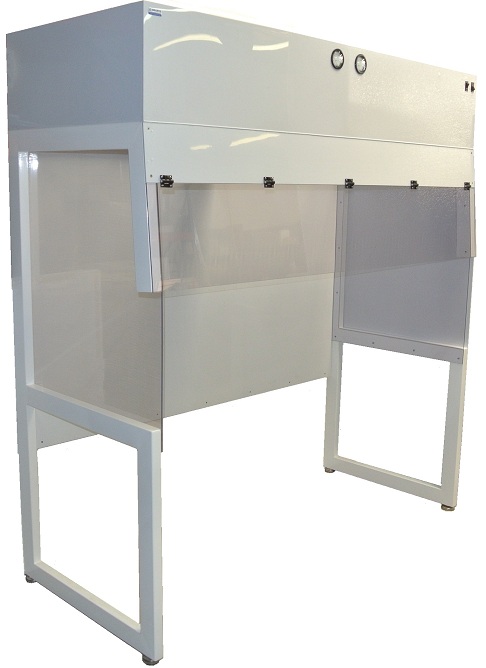Laminar Flow Hoods are highly specialized equipment that allows obtaining a sterile and safe area for any need that is required within a laboratory. They can be Horizontal and Vertical. It basically constitutes a space; which, through a specific air treatment; allows working in an area with strict control of non-road particles. This type of equipment is used for certain processes where it is necessary to control contamination.
The Typical Options
Typically, these systems are used for microbiological control procedures; packaging process, sterile filling, etc. but in no way should they be used for processes involving strains of contaminating biological agents; whether they are known or not. For these cases, there are biological safety cabinets, prepared for the protection of the product/process, the operator, and the environment.
The purpose of the equipment is to protect:
- The worker from the risks associated with the handling of potentially infectious biological material.
- The sample being analyzed so that it does not become contaminated.
- Environment.
What is laminar flow?
The laminarity is generated thanks to a constant speed in the air outlet that allows homogenizing the distribution in the workplace. This is possible thanks to the placement of HEPA filters as a previous step to the air outlet. However, considering a complete room with filters of these characteristics would be extremely expensive, and the question we must ask ourselves and if we really need the entire surface covered with HEPA filters. While these systems may differ in some construction characteristics, maintaining a constant laminar airflow is critical to the goal. So it turns out that we could reduce the requirement to a clean or ultra-clean area, instead of thinking about the entire area under this condition.
There are two main sources of contamination in an area with specific control requirements, these can be external (associated with the environment), and internal (produced within the area either by personnel or by the type of work). In the case of the former, the reduction of pollution is achieved with the different filtering stages through which the outside air must pass until it reaches the environment. In the case of the latter, it is necessary to work on strict procedures, both for the development of the activity and for cleaning, even considering possible events.
How does a laminar flow hood work?
Laminar Flow Hoods contribute to the recirculation of clean air in the environment where they are located; being that they have a continuous work of air renewal. Let’s not forget that they take it from their environment. They filter it and return it to the environment with an extra stage of absolute filtration, and this process is constant.
In the case of laminar flow hoods, the constant, continuous air outlet velocity and homogeneous distribution through HEPA filters, allows the particles generated in the work area to be displaced, causing a sweeping effect out of the said area. This mechanism achieves a grade A workspace with a very low concentration number of different-sized particles.
Why should I use a laminar flow hood?
Now, if we understand that the laminar flow system provides us with a work area free of polluting particles; that in addition, the site environment will benefit from continued use; as much as the use of a controlled environment will be advantageous for the operation of the system; We can consider that many times the failures associated with the operation of the equipment are due to the way they are used.
- We must understand that a laminar flow hood. It is not a storage unit, nor a desk, nor a receptacle for waste, but a critical work tool. Therefore, it is important to provide it with adequate care and maintenance to allow it to work with consistent results throughout its useful life.
- The laminar flow hood is a work table or similar enclosed space, which creates a particle-free environment, drawing air through a filtration system and expelling it through the work surface using a laminar or unidirectional air stream.
- The laminar flow hood is side sealed and is kept under constant positive pressure to prevent infiltration of contaminated ambient air.
- It is widely used in medical research laboratories, hospitals, manufacturing, and other research and production environments.
Last Words
Within the scientific, pharmaceutical, and clinical industries, it is essential to have spaces that are free of bacteria or microorganisms that can contaminate the workspace. This is why laminar flow hoods are those tools that allow obtaining a sterile and safe area for any need that is required within a laboratory.








